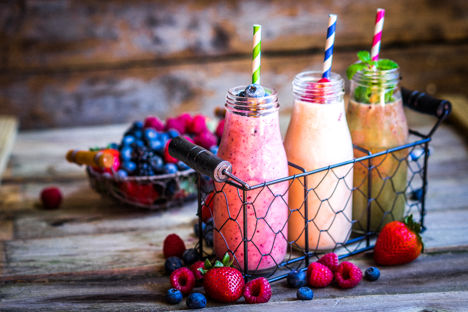
Tips and tricks for making smoothies
Tom Wildman peels, chills and blends his way towards the ultimate smoothie, learning how to get the perfect consistency, maximise flavour and cram as many healthy ingredients as possible into every glass.
Tips and tricks for making smoothies
Tom Wildman peels, chills and blends his way towards the ultimate smoothie, learning how to get the perfect consistency, maximise flavour and cram as many healthy ingredients as possible into every glass.
Smoothies are fast, easy, incredibly versatile and great either as a kickstart to your day or as an afternoon pick me up. In its simplest form, a smoothie is a combination of liquid, fruit or vegetables and maybe some ice. By blending these components together, you immediately have a refreshing and flavoursome drink that is full of healthy goodness.
Making your own is far better value than the store bought alternatives, with the added advantage of knowing exactly what goes into your finished drink. This guide goes through some basic principles for smoothie making, but the fun is all in the experimentation, so have a rummage through your fridge or freezer and blend up a storm.
Fill your freezer
Freezing your fruit has several benefits when it comes to making smoothies. There’s no need to use ice to keep things cool, and by getting into the habit of freezing surplus fruit and vegetables you always have the base of a smoothie to hand. With a little prep, most fruit freezes very well. Strawberries should be hulled, bananas skinned and chopped and apples and pears need their cores removed. For ease of use it’s also best to cut your fruit into blendable chunks before freezing, enabling you to avoid any washing up in the morning and allowing a few extra minutes of snooze time.
To do this, chop your desired fruit into even-sized chunks and arrange on a flat baking tray, lined with baking paper. Make sure the fruit isn’t touching to stop it freezing together, then freeze overnight. The next day, place the fruit in a freeze-proof bag and use as desired.
Alternatively, use store-bought frozen fruit mixes. Most supermarkets sell convenient packs of frozen fruit in various combinations. Quality can vary from brand to brand, but if you’re after ease and simplicity you can’t do better.
Consistency is king
The key to the perfect smoothie is getting the right ratio of liquid to solid ingredients. Everyone has different ideas on what the ideal smoothie consistency should be. Some like theirs to be liquid, while others prefer a thick, milkshake-like consistency. If you're like me and fall somewhere in the middle, you need a natural thickener for that perfect creamy finish. There are many ingredients you can use to do this: banana is the most popular, but avocado and coconut flesh also does the trick.
Chia seeds are currently riding a wave of popularity as the latest superfood trend and are packed full of important nutrients. They also make a great addition to smoothies: mix a tablespoon of chia seeds with three tablespoons of water and you have your own chia seed gel – a natural thickener that can also be used as a vegan-friendly alternative to eggs in baking.
For the liquid, you don’t have to stick to water. Fruit juices can add an extra hit of fruit flavour or you can use milk or a dairy-free alternative such as almond or soya milk. If using mango or pineapple, you could continue the tropical theme with the addition of coconut milk or water.
Supercharge your smoothie
To get the maximum amount of health benefits out of your smoothie, consider adding vegetables, herbs, seeds and other superfoods. A handful of dark green leafy vegetables such as kale, spinach and watercress will add an immune-boosting hit of nutrients, and ingredients such as goji berries, acai berries or flaxseed are incredibly good for you. Peter Gordon adds a tablespoon of baobab powder, another much-touted superfood, to his delicious blueberry smoothie.
Get inspired
The basic smoothie formula can easily be converted into a soup, dessert or even breakfast, as demonstrated by Bruno Loubet’s delicious Rhubarb smoothie with custard and granola. For example, tomatoes, peppers, cucumber, garlic, ice and a little vinegar can quickly be whizzed together to make the refreshing spanish chilled soup Gazpacho – perfect for lunch on a hot day. If time is on your side and you have access to a freezer, a thick creamy ice cream can be made from strawberries, cream and a little icing sugar, or for a healthier option, freeze a blend of citrus juice, ice and sugar syrup for a natural light sorbet or granita.


